Selinunte
Selinunte (full name Marinella di Selinunte) is a district of the village Castelvetrano on the south coast of Sicily, Italy. It is most famous for the neighbouring ruins of the Greek city of Selinus in the archeological park Selinunte (italian: Parco archeologico Selinunte). This park is a main tourist attraction in this region.
Understand
Selinunte was founded around 700 BC by colonists from the Greek city Megara (an independent city-state 35 km from Athens). Around 580 BC a conflict broke out with the native Elymians from Segesta. To obtain support the Greeks of Selinunte entered into a covenant with Carthage and later with Syracuse. Even in times of peace a smoldering conflict remained with Segesta. In 415 BC Segesta persuaded Athenians to send an expedition, however this did not result into a clash with Selinunte. In 409 BC expelled Carthaginians landed from Motya at Marsala and warred against Selinunte. They took over the city after a ten-day siege. The displaced residents returned after the demolition of the city walls and entered into a covenant with the Carthaginians. As an ally of the Carthaginians the city regained power and grandeur. Around 250 BC, after the first Punic war against the Romans, the Carthaginians destroyed the city and retreated to Lilybaeum. Selinunte was never rebuilt and matured over the centuries to ruins. In the 19th century the ruins of the city were barely recognizable. In the 20th century, the temples on the eastern hill were excavated. In 1950 temple E was reconstructed on a controversial manner and the excavations of the Acropolis were started.
Climate
Get in
By plane
- Trapani (Vincenzo Florio Airport), ☎ +39 923 610 111. TPS IATA
By car
Leaving Trapani take the A29 to the south, then exit heading Castelvetrano and follow SS115 to Marinella di Selinunte. Take the first exit to the right at the roundabout in Marinella. After 50 meters you will find a parking lot and the access to the park.
By train
The nearest train station is in Castelvetrano. Information about train connections can be found on the website of Trenitalia.
By bus
The bus transportation company Salemi runs 4 times a day from the railway station in Castelvetrano to Marinella di Selinunte. However the timetables are 'not entirely reliable' so be prepared for a long wait.
Park entrance
- Parco Archeologico Selinunte, ☎ +39 092 446 540. 9AM-7PM (No entrance after 6PM). €6.00.
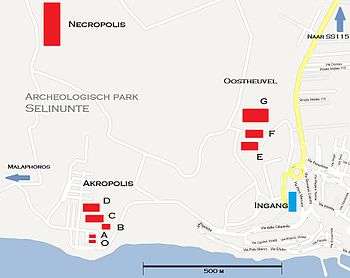
Get around
The archaeological site of Selinunte is divided in several parts. The eastern hill area with the temples E, F and G. One kilometer further at sea the ruins of the old walled city with the Acropolis and temples A, B, C, D and O. Further west lies the shrine Malaphoros with a Necropolis. In the north part is a large Necropolis. All areas are connected with walking trails, however you can take the tourist train (Trenino) for € 6.00. Because it can be very hot, it is advisable to go as early as possible as there is little shade. Wear good walking shoes and take plenty of water. The park is at its best in spring with flower fields and with far fewer tourists than during high season. Opposite the entrance of the park you can buy soft drinks and sandwiches. At the East Hill and near the Acropolis are toilets.
See
- East hill (italian: Collina orientale)
- Temple E: the classic Doric temple E, devoted to Hera, has an area of 70,2 x 27,6 m (15 x 6 columns) and was built between 460 - 450 BC. Four Metopes (decorative elements) can be found in the archeological museum of Palermo. The temple was reconstructed in 1959 in a controversial manner. Most tourists don’t care about this as the temple illustrates its heydays on a spectacular way. Temple E is the most photographed object in the park.
- Temple F: this is the smallest temple with an area of 61,8 - 24,4 m (6 x 14 columns). It is assumed that the temple is devoted to Dionysos. It was built between 550-520 BC. The stones of the temple were used for other purposes after his collapse. Metopes of this temple are also housed in the Archaeological Museum of Palermo.
- Temple G: This is the temple of Zeus with an area of 113 x 54 m (17 x 8 columns). It is the largest of Selinunte and one of the largest of entire Greek antiquity. Its construction was started in 530 BC and it is believed that the construction was not yet completed when the city was destroyed.
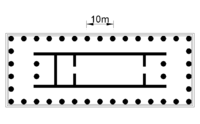 Temple E | 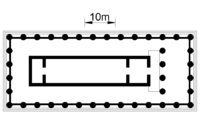 Temple F | 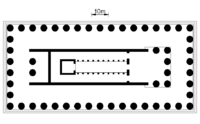 Temple G |
Temple E | 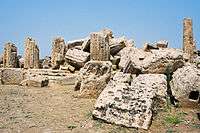 Temple F | 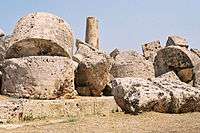 Temple G |
- Acropolis
- City wall: The city wall was restored after the destruction by the Carthaginians and surrounded the entire old town. Even now remains are still visible e.g. at the northern city port.
- Temple O: Only a few parts are left of this most southern temple on the acropolis. The temple had an area of 40,2 x 16,2 m (14 x 6 columns).
- Temple A: This temple is identic to temple O. The altar is found as well as spiral staircases leading to the Naos (the most holy room of the temple).
- Temple B: With an area of 8,4 x 4,6 m (4 columns in the front) temple B is the smallest temple. It is devoted to Empedokles. The colorful temple was discovered by J. Hittorf in 1824.
- Temple C: This temple was devoted to Apollo and has an area of 63,7 x 24 m (17 x 7 columns). It is the oldest and most glorious temple of Selinunte. Some metopes are housed in the Archaeological Museum of Palermo.
- Temple D: This temple with an area of 56 x 24 m (6 x 13 columns) is located further north.
- Megaron: This building with an area of 17,8 x 6,3 m was built 580 BC. A Megaron is a sanctuary.
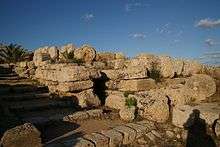 Temple A |
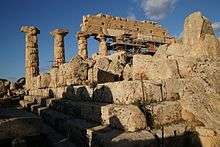 Temple C |
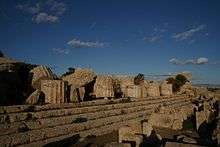 Temple D | |
- The sanctuary of Malophoros – This part of the park is located in the west and can be reached by a trail that leads over the river Modinone.
- Temple N / Sanctuary of Hera: is a small temple with a big altar devoted to the goddess Hera.
- Sanctuary of Demeter Malophoros: This Megaron is devoted to Demeter Malophoros. 12.000 terracotta attributes were found here.
- Temenos of Zeus Meilichios: Inmediattely right of the Demeter Malophoros sanctuary is an altar devoted to Zeus.
- Source of Gaggera / Antiquarium: is a small museum which is partially built over the antique edge of the source. Local founding’s are displayed here.
- Necropolis: Parts of the tomb paintings that are found on the necropolis at the east side of the Modinone are on display in the visitor center at the Acropolis.
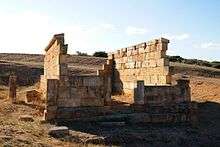 Temple N (West hill) | 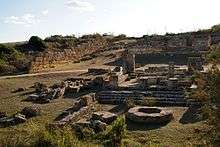 Sanctuary of Demeter Malophoros (West hill) | 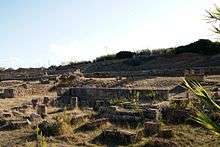 Sanctuary of Zeus Meilichios |
Buy
Souvenir stalls can be found opposite the entrance. They sell ceramics with archeological images. Postcards are probably a good choice.
Eat
There are no restaurants inside the park. A lot of restaurants can be found in Marinelle di Selinunte.
- Olimpo S.A.S. Di Maggio Benito & C, Via Giovanni Caboto, 132. Marinella, ☎ +39 092 446 876.
- Fontana Natale, Via Marco Polo, 49. Marinella, ☎ +39 092 446 211.
- Ristorante Giulio Cesare Di Cavarretta Emanuela, Via degli Argonauti, 18. Marinella, ☎ +39 092 446 335.
Drink
- Bar Pinguino, Via del Cantone, 3 (In Marinella near the marina), ☎ +39 092 446 231, e-mail: tommasoscire@gmail.com.
Sleep
- Hotel Garzia (Hotel Miramare), Antonio Pigafetta, 2. Marinella, ☎ +39 092 446 024, e-mail: info@hotelgarzia.com. Some rooms in the front have large terraces with sea views. From €70.
- L'Oasi di Selinunte Hotel, Via Pitagora. Marinella, ☎ +39 092 446 885, e-mail: info@loasidiselinunte.it. 4 star hotel with s.p.a. and swimming pool. From €65 p.p..
- Triscinamare, Viale Mediterraneo, 233. Triscina, ☎ +39 092 484 082. This hotel has apartments and attached rentals. Terrace with swimming pool. From €45.
- Camping Il Maggiolino, ss 115 Dir. A 106. Marinella (Niet ver van de ingang van het park), ☎ +39 092 446 044, e-mail: info@campingmaggiolino.it. Chalets for rent
Stay healthy
Heat is your biggest enemy. Prepare well: wear headgear and put on sunglasses. Provide adequate drinking water.
Cope
- Alarm, ☎ 112.
- Police, ☎ 113.
- Fire department, ☎ 115.
Go next
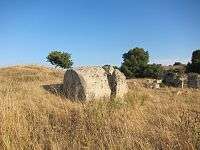
- Cave di Cusa – Cave di Cusa (sometimes called Rocche di Cusa) was an old quarry that already was used in the 6th century BC. to get building stones for Selinunte. These days it is an official archaeological tourist destination. The entrance fee is €2. The place is located 3 km south of Campobello di Mazara, that is 12.5 km west of Marinella di Selinunte. Especially in spring, it is a wonderful place for a picnic
- Triscina di Selinunte – At about 10 km to the west of the park lies resort Triscina di Selinunte. This place has extensive beaches and is free from mass tourism. It is only a 2 km walk between Marinella and Triscina crossing the archaeological site.
- Tre Fontana – A few kilometers west of Triscina is Tre Fontana. In summer this is a real beach resort with many facilities and a waterpark (Acqua Splash).
- Castelvetrano - Visit the Museo Civico in Castelvetrano with the Ephebo di Selinunte, a bronze sculpture from 480-460 BC. Address: Via Giuseppe Garibaldi, 50. Phone:39 0924909605.